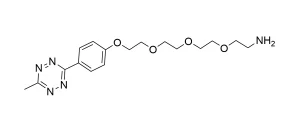S-acetyl-dPEG®4-OH, product number QBD-10156, is a PEG modifier designed to allow the thiolation of biomolecules. The hydroxy terminus reacts with activated carboxylic acid esters and isothiocyanates, and the acetyl protecting group can be removed easily under relatively mild conditions.
S-acetyl-dPEG®4-OH, product number QBD-10156, contains an acetyl-protected thiol on a short, hydroxy-terminated, discrete polyethylene glycol (dPEG®) linker. This product is designed for the thiolation of biomolecules.
Bioconjugation frequently employs thiolation because the reactions to install thiol groups on molecules or to react with molecules containing sulfhydryl groups are relatively simple and often chemoselective. The thioacetyl group is intended to install an acetyl-protected thiol onto biomolecules. While installing a protected thiol through a reaction between a carboxylic acid and a primary amine is widely popular in bioconjugation technology, it is not always possible or feasible. S-acetyl-dPEG®4-OH permits the installation of a protected thiol through a short, hydroxy-terminated discrete PEG® linker that can be installed by the reaction of hydroxy group with an activated carboxylic acid ester or isothiocyanate group. Hydroxylamine hydrochloride (CAS number 5470-11-1) easily removes the acetyl group that protects the thiol, thus exposing the sulfhydryl for reaction. One application for S-acetyl-dPEG®4-OH is the modification of nucleic acids using phosphoramidite chemistry.
| Unit Size | 100 mg, 1000 mg |
|---|---|
| Molecular Weight | 252.33; single compound |
| Chemical formula | C₁₀H₂₀O₅S |
| CAS | 223611-42-5 |
| Purity | > 98% |
| Spacers | dPEG® Spacer is 13 atoms and 14.6 Å |
| Shipping | Ambient |
| Typical solubility properties (for additional information contact Customer Support) | Methylene chloride, Acetonitrile, DMAC or DMSO. |
| Storage and handling | -20°C; Always let come to room temperature before opening; be careful to limit exposure to moisture and restore under an inert atmosphere; stock solutions can be prepared with dry solvent and kept for several days (freeze when not in use). dPEG® pegylation compounds are generally hygroscopic and should be treated as such. This will be less noticeable with liquids, but the solids will become tacky and difficult to manipulate, if care is not taken to minimize air exposure. |
Greg T. Hermanson, Bioconjugate Techniques, 3rd Edition, Elsevier, Waltham, MA 02451, 2013, ISBN 978-0-12-382239-0; See Chapter 18, Discrete PEG Reagents, pp. 787-821, for a full overview of the dPEG® products.
5’-Sulfhydryl-Modified RNA: Initiator Synthesis, in Vitro Transcription, and Enzymatic Incorporation. Lei Zhang, Lele Sun, Zhiyong Cui, Robert L. Gottlieb and Biliang Zhang. Bioconjugate Chem.2001, 12 (6) pp 939–948. October 16, 2001. DOI: 10.1021/bc015504g.
Applicable patents and legal notices are available at legal notices.




Stay in the Loop. Join Our Online Community
Products
Ordering
About Us
Application
Resources

©Vector Laboratories, Inc. 2025 All Rights Reserved.
To provide the best experiences, we use technologies like cookies to store and/or access device information. Consenting to these technologies will allow us to process data such as browsing behavior or unique IDs on this site. Not consenting or withdrawing consent, may adversely affect certain features and functions. Privacy Statement
How do I Request a Quote?
To request a quote for products: